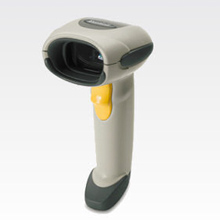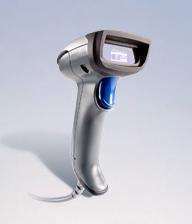Speed, Functionality and Expanded Usage Push 2D Imaging Scanners Ahead of Laser Scanners
 Laser scanners developed specifically for reading linear bar codes reached a peak of popularity in 2008. Since that time, however, 2D imaging scanners have overtaken regular bar code scanners because of their speed, functionality and expanded usage. 2D imaging scanners take a “snapshot” of the bar code and then decode it. Unlike laser scanners, they can read QR Codes, Data Matrix and other 2D symbols, and can also take digital pictures, shoot video, capture signatures, scan and process data.
Laser scanners developed specifically for reading linear bar codes reached a peak of popularity in 2008. Since that time, however, 2D imaging scanners have overtaken regular bar code scanners because of their speed, functionality and expanded usage. 2D imaging scanners take a “snapshot” of the bar code and then decode it. Unlike laser scanners, they can read QR Codes, Data Matrix and other 2D symbols, and can also take digital pictures, shoot video, capture signatures, scan and process data.
Motorola’s Venkat Sreenivasan of the Motorola Enterprise Division for Software and Applications noted that the proliferation of mobile bar code applications for smartphones is spurring retailers to install 2D imaging scanners. He predicts the top four uses for 2D bar codes, or mobile bar codes, will be:
-Mobile coupons, primarily because they are “cheap and green,” always available and don’t require clipping
-Loyalty cards, which will replace key-ring fobs
-Mobile gift cards, which are easy to give, carry and redeem
-Games and contests, as smartphones allow two-way texting between advertisers and consumers.
Cedric Mollon of Intermec agrees, and adds, “2D imaging scanners go beyond reading barcodes. They extend customers’ application reach, adding value and ROI within their processes. Three of the latest Intermec 2D Image processing capabilities include: first, the ability to capture a handwritten signature on a proof of delivery, then sending and filing the image to a customer’s main data base. This improves customer service and operator’s effectiveness. Second, with Verdex, we can capture name and address on a parcel or envelop, identify, control and correct the data if necessary to improve track and trace efficiency by 300 percent. And third, Enhanced Mobile Document Imaging (eMDI) provides a fast and reliable way for mobile workers to convert full-sized paper documents into electronic files, thus reducing document management costs, streamlining back office operations, and improving cash flow and responsiveness to customer requests.”
Speed
2D imaging scanners enable fast scanning and better productivity because they can read bar codes moving up to 500 inches per second. There’s no need to realign labels, so no scan line is required.
Functionality
2D imaging scanners take a picture of the symbol to be read so they can process bar codes displayed on cell phones, TVs, PCs and PDAs. This level  of functionality virtually guarantees against obsolescence as mobile marketing continues to emerge and evolve.
of functionality virtually guarantees against obsolescence as mobile marketing continues to emerge and evolve.
Additionally, the fact that 2D imaging scanners can be used to capture signatures is useful when workers without mobile devices need an approval signature to append to the transaction record.
Usage
2D imaging scanners are beneficial for applications that involve sorting and processing variable-sized objects, which is why imagers are becoming popular for POS, check-in/check-out and other apps. Additionally, they can scan a group of items, rather than individually, and can capture data from more than 50 feet away. This is particularly useful in retail, pharmacy, shipping (proof of delivery and proof of condition), compliance issues – even for training purposes.
Take the mobile worker for example. He or she is able to order forms, obtain signatures, add notes and other information about specific clients – even update inventory data – and then upload to the central office where it’s integrated into the computer system. This saves hours of manually entering the data once from the field and then again at corporate, which leads to increased productivity and the savings of thousands of labor-intensive dollars.
The capabilities of 2D imaging scanners are especially relevant to the warehouse inventory environment, since often multiple and various types of bar codes need to be scanned from varying angles and distances.
2D imaging scanners can also read information from drivers’ licenses. Law enforcement officers can scan licenses and auto VIN numbers of drivers stopped for traffic violations, thus capturing the information and the reason for the warning, citation or arrest.
Additionally, business cards and other forms of identification to save data entry time and ensure accuracy. Even digital pictures or video can be shot and then uploaded from the imager.
The technology is also applicable to the Currier, express and parcel (CEP) industry. CEP deals with millions of items, large and small and in varying shapes and weights. Some have unverified addresses, many of which ultimately become “Undeliverable as Addressed.” Intermec has developed Verdex software specifically for precision address verification at the point of parcel collection.
Future Issues
It’s no secret that business processes are changing rapidly, and technology needs to either lead the way or follow in lightning-speed time. Documentation of package delivery (or reasons why the delivery could not be completed), couponing, tickets sent and received via cell phones, enhanced bar code data parameters, inventory control, training purposes – all of these issues and more indicate that businesses want and need more information to stay ahead of the curve.
A 2011white paper published by Intermec offers a compelling look at 2D imagers and why they are surpassing laser scanners for multiple-format bar code reading (www.intermec.com/public-files/white-papers/en/WP-2D-ImagersMoveMainstream.pdf).
Related articles:
Intermec Benefits from Rising 2D Scanner Trend
Vega V-1020 Handheld 2D/1D Bar Code Scanner Sells While it Scans
{jcomments on}
